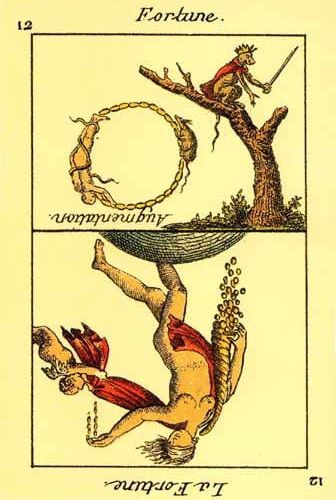kwaw
Etrennes nouvelles de l'horoscope de l'homme et de la femme" By M. G. D. R., published by G. Quinet, Libraire, dans la Salle du Palaise, uses an expanded piquet set of 36 cards, and a 9x4 spread.
It is available online here:
https://books.google.co.uk/books?id...KAhXKXRQKHXvaAbIQuwUIJTAA#v=onepage&q&f=false
The names of the positions in the 1788 9x4 spread:
1 projet; 2 satisfaction; 3 reussite; 4 esperance; 5 hazard; 6 desir; 7 injustice; 8 ingratitude; 9 association; 10 perte; 11 peine; 12 etat; 13 joie; 14 amour; 15 prosperite; 16 mariage; 17 affliction; 18 jouissance; 19 heritage; 20 trahison; 21 rival; 22 present; 23 amant; 24 elevation; 25 bienfait merite; 26 enterprise; 27 changement; 28 death; 29 recompense; 30 disgrace; 31 bonheur; 32 fortune; 33 indifference; 34 faveur; 35 ambition; 36 maladie.
L'Oracle Parfait after Mlle Lenormand:
1, projet; 2, satisfaction; 3, réussite; 4, espérance; 5, hasard; 6, désir; 7, injustice; 8, ingratitude; 9, association; 10, perte; 11, peine; 12, état; 13, joie; 14, amour; 15, prospérité; 16, mariage; 17, affliction; 18, jouissance; 19, héritage; 20, trahison; 21, rival; 22, présent; 23, amant; 24, élévation; 25, bienfait; 26, entreprise; 27, changement; 28, fin; 29, récompense; 30, disgrâce; 31, bonheur; 32, fortune; 33, indifférence; 34, faveur; 35, ambition, 36, indisposition.
It is available online here:
https://books.google.co.uk/books?id...KAhXKXRQKHXvaAbIQuwUIJTAA#v=onepage&q&f=false
The names of the positions in the 1788 9x4 spread:
1 projet; 2 satisfaction; 3 reussite; 4 esperance; 5 hazard; 6 desir; 7 injustice; 8 ingratitude; 9 association; 10 perte; 11 peine; 12 etat; 13 joie; 14 amour; 15 prosperite; 16 mariage; 17 affliction; 18 jouissance; 19 heritage; 20 trahison; 21 rival; 22 present; 23 amant; 24 elevation; 25 bienfait merite; 26 enterprise; 27 changement; 28 death; 29 recompense; 30 disgrace; 31 bonheur; 32 fortune; 33 indifference; 34 faveur; 35 ambition; 36 maladie.
L'Oracle Parfait after Mlle Lenormand:
1, projet; 2, satisfaction; 3, réussite; 4, espérance; 5, hasard; 6, désir; 7, injustice; 8, ingratitude; 9, association; 10, perte; 11, peine; 12, état; 13, joie; 14, amour; 15, prospérité; 16, mariage; 17, affliction; 18, jouissance; 19, héritage; 20, trahison; 21, rival; 22, présent; 23, amant; 24, élévation; 25, bienfait; 26, entreprise; 27, changement; 28, fin; 29, récompense; 30, disgrâce; 31, bonheur; 32, fortune; 33, indifférence; 34, faveur; 35, ambition, 36, indisposition.



